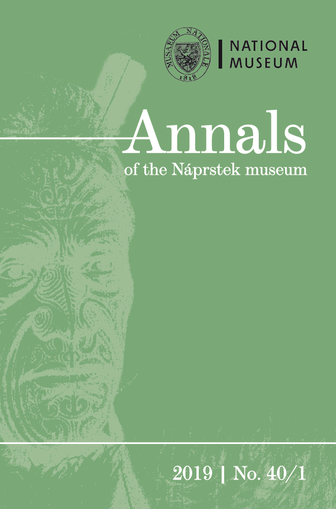
2019/40/1
ISSN : 0231-844X (print), 2533-5685 (online)
Editor in Chief : Jiří Honzl (executive editor)
Editor in Chief : Jiří Honzl (executive editor)
Traditions and Innovations in the Clothing of Southern Altaians
Tereza Hejzlarová
The study deals with the traditional clothing of the Southern Altaians – Altai-Kizhi and Telengits, living in the territory of the Altai Republic in the Russian Federation, its common features, ethnic specifics and, above all, the changes it has gone through since the second half of the 18th century…
Gottfried Lindauer and the Náprstek Museum: Ethnographic Collection
Gabriela Jungová
Gottfried Lindauer was a Bohemian painter residing and working in Aotearoa New Zealand. His paintings capturing the native people and their life earned him praise and respect from the Māori and Pākehā alike, as well as international recognition within and outside the artistic community. The Naprstek…
Means of Transport by Udehe: The Transformation and Survival of Material Culture
Vladimir Degtiar
The purpose of this paper is to describe how the material culture of the indigenous hunters and fishermen of the Udehe in the Far East of Russia have been transformed by outside influence, from an autonomous and already sophisticated culture to a dependent and modernized one. The discussion centres…
The Story of Storyboards from East Sepik, Papua New Guinea
Martin Soukup, Dušan Lužný
This study analyzes and interprets East Sepik storyboards, which the authors regard as a form of cultural continuity and instrument of cultural memory in the post-colonial period. The study draws on field research conducted by the authors in the village of Kambot in East Sepik. The authors divide…
Secondary Burial Ground in the Pyramid Complex of King Djedkare: A Preliminary Report on Burials with Grave Goods
Hana Vymazalová
The exploration of the pyramid complex of King Djedkare at south Saqqara in 2018 revealed a large number of secondary burials. These burials were found between the north part of the king’s funerary precinct and in the south part of his queen’s precinct in an area which had not been previously…
Spectacles and Embroidered Spectacle Cases from China in the Náprstek Museum
Helena Heroldová
Spectacles from China appear in many museum collections, and they are popular collectibles in private collections. The collection of ten spectacles and their cases in the Naprstek Museum in Prague shows its technological and material development from the pince-nez type in the second half of the 19th…
Iranian Blue-and-White Ceramic Jar
Jindřich Mleziva
Museum collections often contain items that are inaccurately, or even wrongly, identified. This was the case of a jar belonging to a collection in the West Bohemian Museum in Pilsen. The Iranian jar was apparently acquired at the end of the 19th century and later mistakenly placed in the Chinese…
Preliminary Report on the Sixteenth Excavation Season of the Archaeological Expedition to Wad Ben Naga
Pavel Onderka, Vlastimil Vrtal, Jiří Honzl
During its seventeenth excavation season, the Archaeological Expedition to Wad Ben Naga continued with the exploration of the so-called Palace of Queen Amanishakheto at Wad Ben Naga (WBN 100), as well as with the excavation and protection of the kom located behind the rail track. During the season,…
